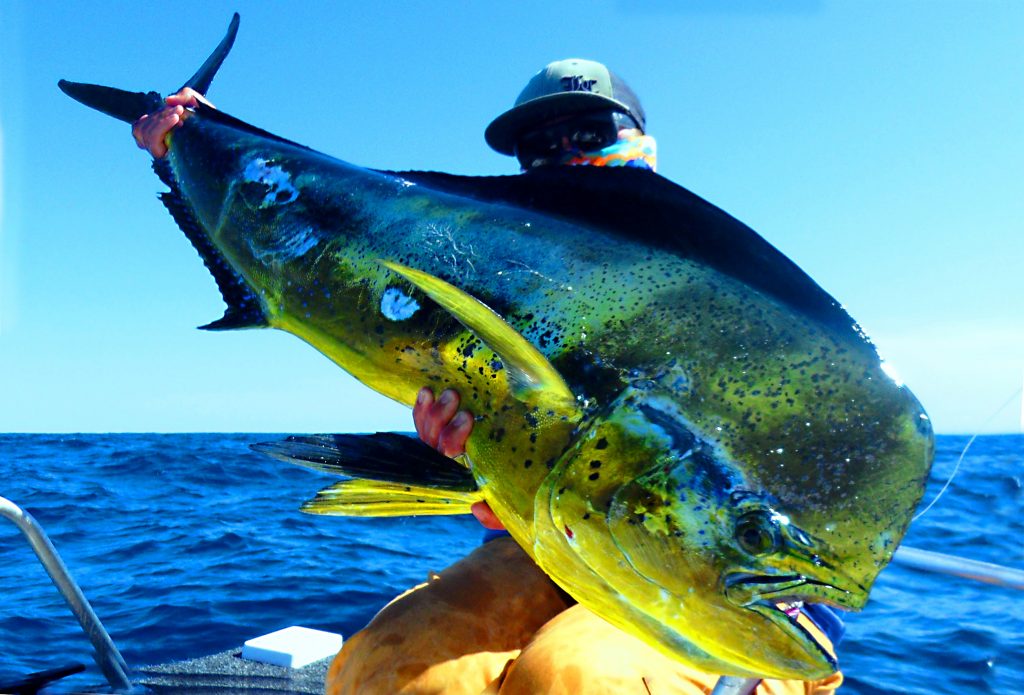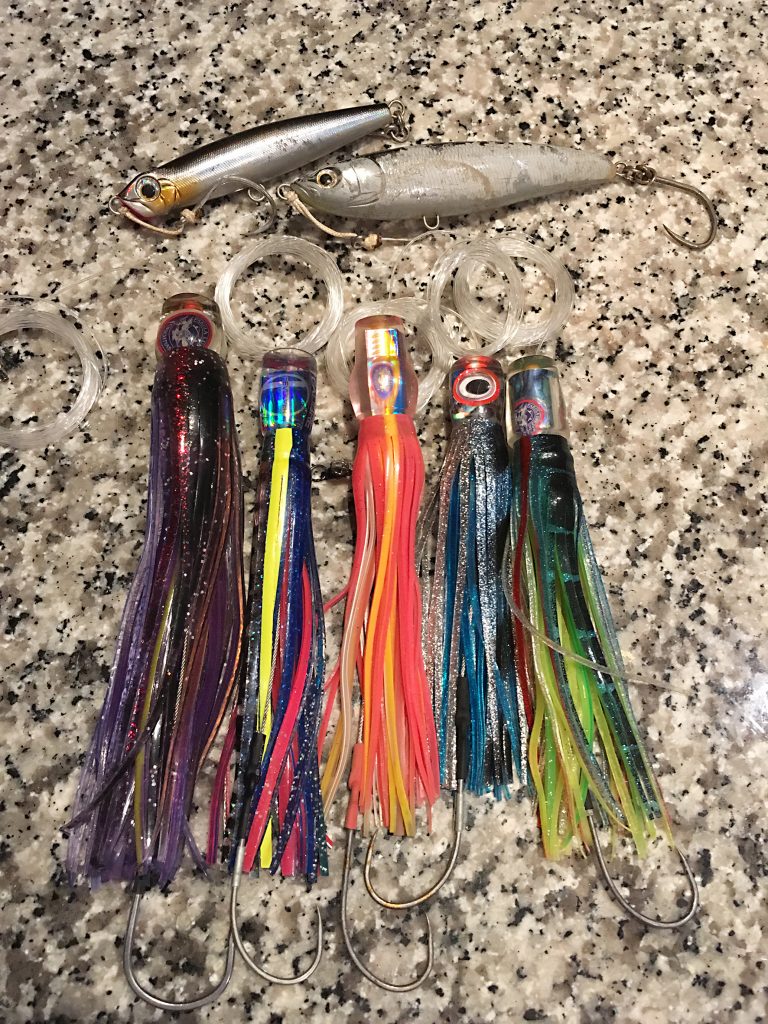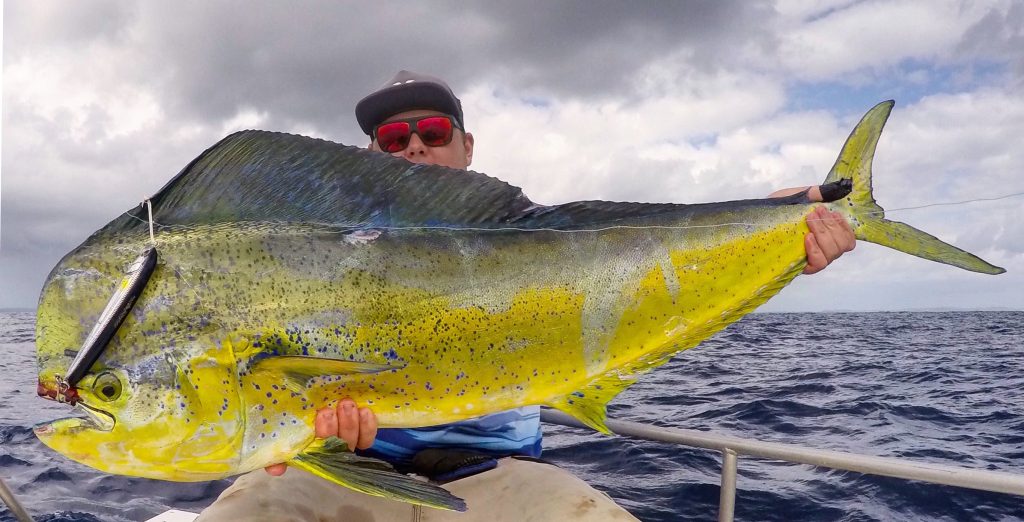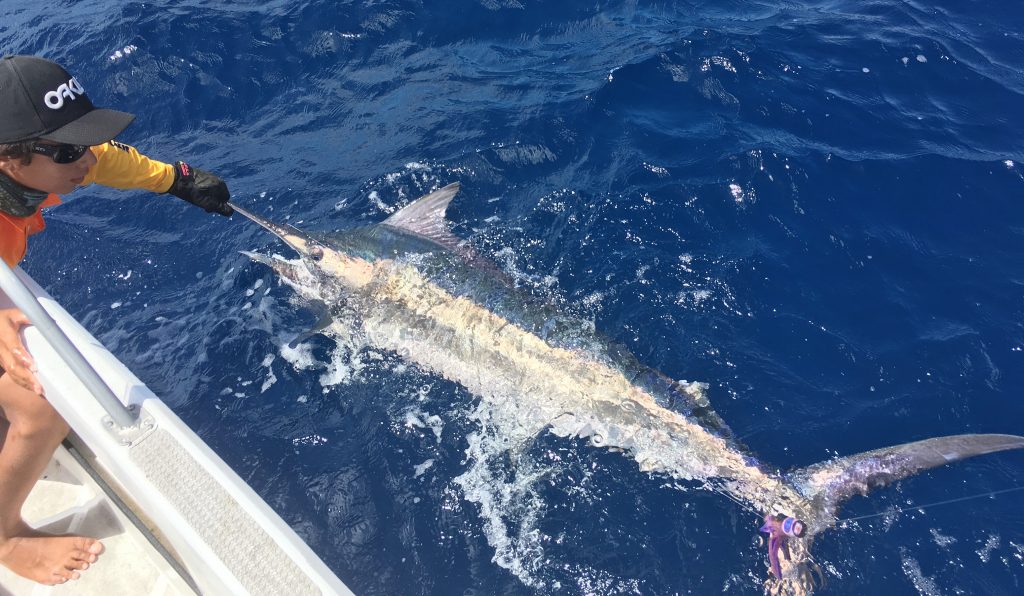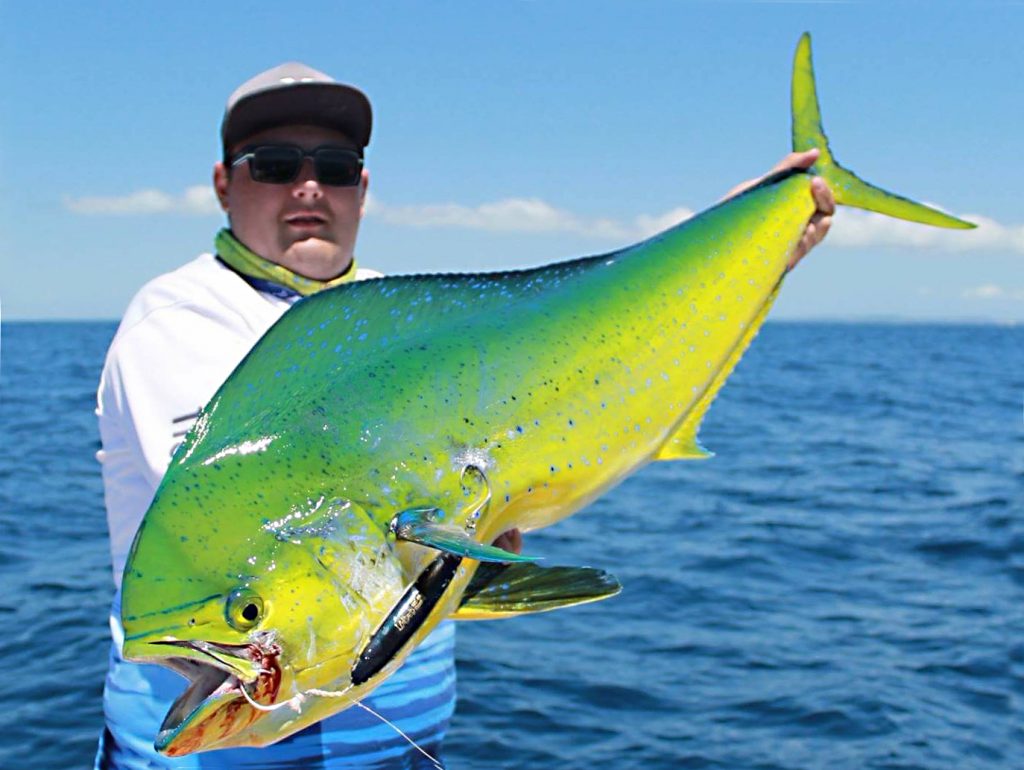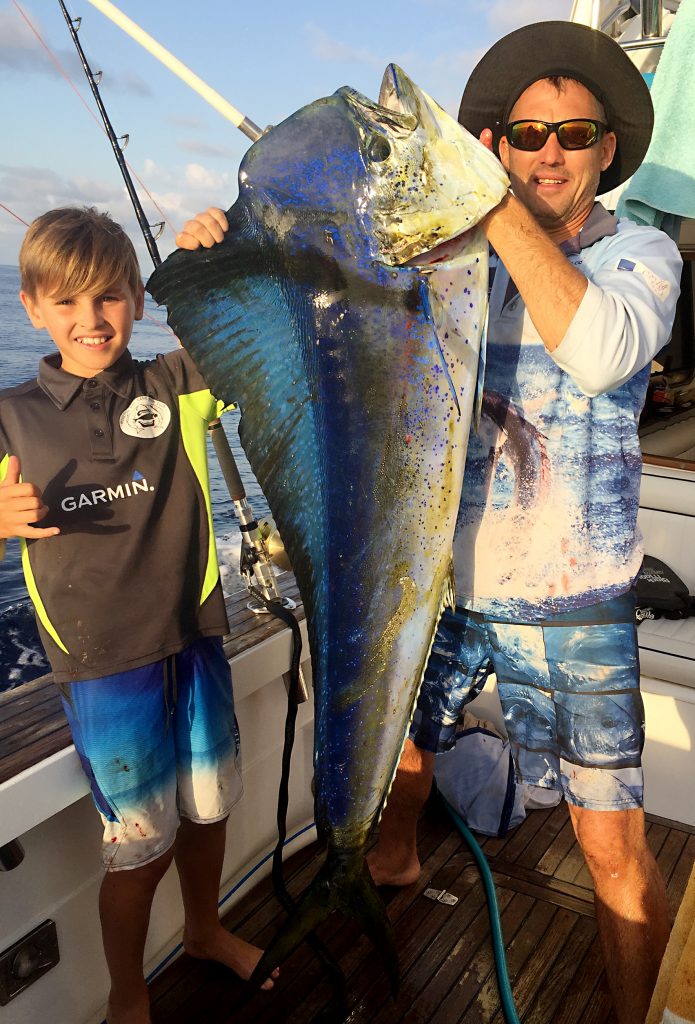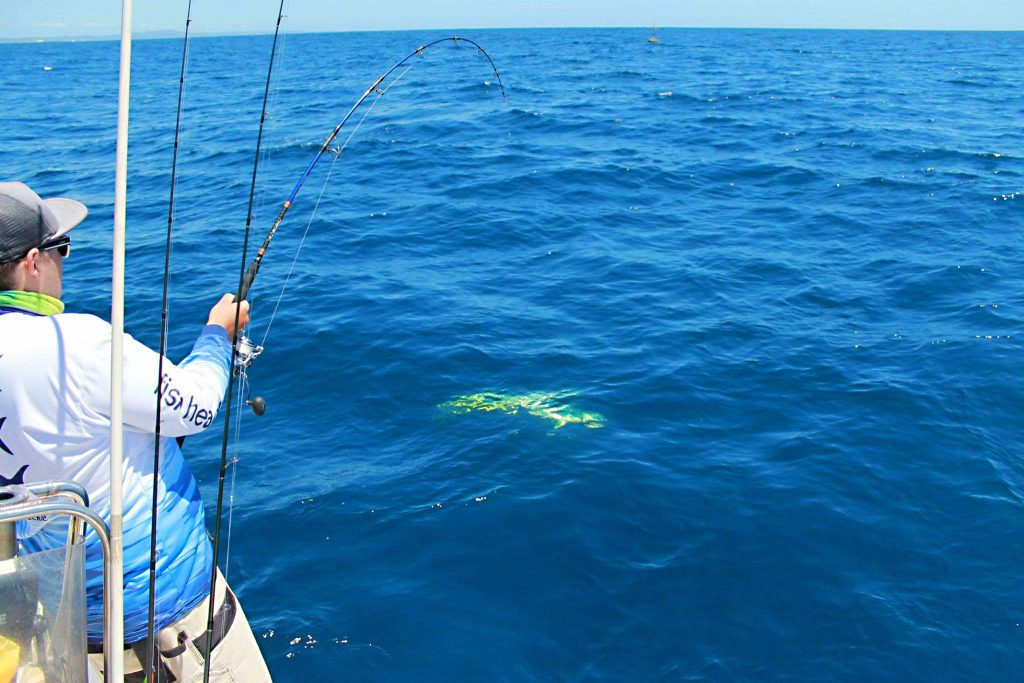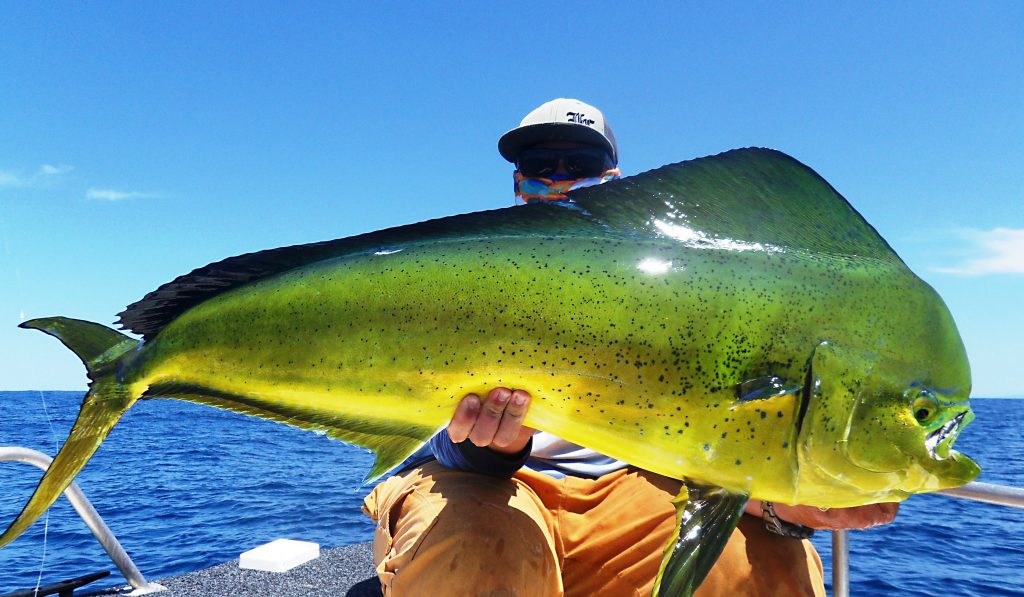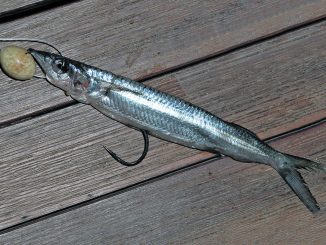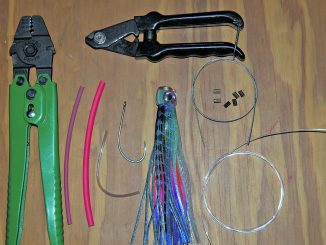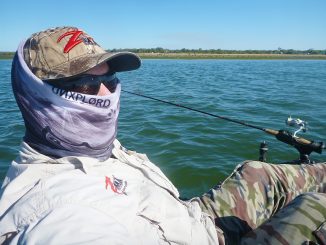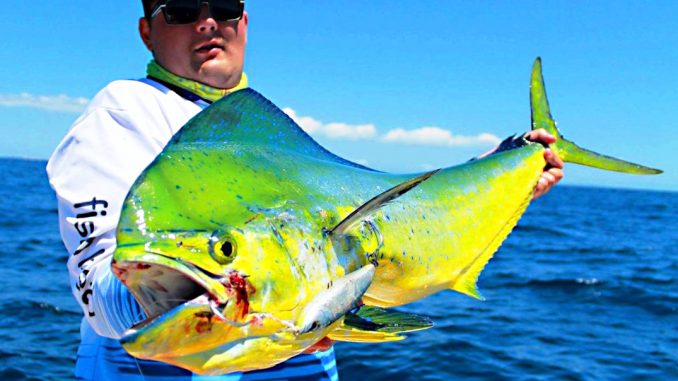
by Kaspar Lenigas •
The warm blue currents of summer have already begun to grace our coastline and that can only mean one thing – pelagic season has begun and there’s no time to waste. The pelagics temporarily visit our coastline on their annual run south along the east coast feeding up before the water temperatures drop and they have to retreat north to warmer waters in winter. By far one of the most acrobatic, stunningly good looking and tastiest of the summer time pelagics has to be the mahimahi.
Luckily for us in Qld, mahimahi can be a year-round capture as long as water temperatures stay above 23°C. Mahimahi are an open water pelagic and can be found from the shoreline at times all the way out to the blue abyss past the continental shelf. As they are an open water pelagic, they rely on the right water temperatures and currents to survive and find their next meal. The rule of thumb I’ve found with dollies is if it swims or flies and can fit in their mouth, they’ll eat it.
Since mahimahi have very short life spans and grow incredibly fast, they need to eat as much as they can as quick as they can. By far one of the best times of the year to target mahimahi is late spring and summer as the summer currents force masses of bait and nutrients down the coastline; the pelagics, including large numbers of mahimahi, are in tow for the free buffet.
There are a couple of ways to catch mahimahi: either trolling open water where they are commonly caught targeting billfish or fishing around floating debris, structure and FADs (Fish Attracting Devices). Before chasing mahimahi you’ll need the right gear. Mahimahi go aerial during the fight, so they are very good at throwing hooks. Billfish are also a likely capture while chasing mahimahi and they are very good at emptying a reel.
Gear and lures
There’s no need to go out and buy a full set of gamefishing setups if you are going to target mahimahi on the troll. Reels that can hold 300m of 30-40lb braid and 6-7ft rods rated from 30-50lb with a relatively soft tip action (spin or overhead) are ideal.
If you’re running spin, I recommend a size 4000-4500 Daiwa or 6000-8000 Shimano. Run a full spool of braid to get the line capacity and run a 20-30m length of 15 or 24kg mono top-shot for shock absorption and stretch to improve hook-ups; the line pressure of the mono through the water can keep the fish hooked as they go aerial.
If you go for an overhead option, a size 15-20 reel is more than adequate. You can get away with using less or no braid backing and running a spool of 15 or 24kg mono, but if you decide you want a full spool of braid so you can use the same setup for bottom fishing, just add a top-shot like you would on a spinning reel. Having 2-3 rods is more than adequate if you want to troll, as its common to have all rods go off at the same time – even if you run five – when you find a school of mahimahi.
When fishing FADs I recommend using a spin rod as it’s important to be able to cast if you use baits or artificial lures. When using live baits or dead bait you can use the exact same spin setup as you would for trolling but instead of the top-shot, run a rod length and a bit of 40-60lb leader and circle hooks. The benefit of a circle hook is that it stops the mahimahi’s small pin-like teeth chafing you off mid-fight, as you’ll hook them in the corner of the jaw; then once it’s in, it’s near impossible for them to shake the hook.
Casting artificial lures is by far one of the most visually exciting ways to target mahimahi and you are able to selectively target larger fish with the lures you use and the way you work them. If you want to cast for them, it’s very important to have the right setup to work the lure and fight the fish. I recommend running a 7-8ft PE2-4 (20-40lb) stickbait rod with a 4000 or 6000 reel running 30-40lb braid and 60lb leader.
The lures I use when casting for dollies are predominately stickbaits from 110-160mm and generally floating, as I like them to skip across the top with ease. Smaller stickbaits that sink relatively fast are great too, as you can sink them down and work them fast to entice a reaction bite.
When rigging stickbaits, it’s single hooks-only – trebles and dollies are a bad idea. Once a mahimahi hits the deck it can become very dangerous with two sets of trebles, as they can go ballistic. Occasionally I’ll use 5-7” plastics and 60-80g jigs, but I prefer the visual aspect of surface lures. There’s nothing better than watching a big bull mahimahi mow down your lure and proceed to go bananas.
When trolling for mahimahi, the best lures you can use are 6-8” skirted lures in a variety of different colours like natural baitfish patterns, oranges, reds, pinks, greens and darker purple and black colours. When rigging skirts, run two arm-lengths of 100lb mono leader attached to a wire hook rig inside the skirt with either a two-hook rig or single hook rig using light gauge and strong 8/0 or 9/0 J hooks. While a two-hook rig is best for mahimahi hook-ups, a single is much safer. To the other end of your 100lb leader crimp a loop and attach a snap swivel to your main line so you can clip your lure on and off with ease.
Trolling
As said before, mahimahi can be found almost anywhere but a good starting point is from 20-100m. Zigzagging your way up and down the contour lines working in, say, 20-60m and 60-100m, most of the mahimahi you find in this depth will generally range from 5-15kg with the odd bigger fish. If you work the shelf from 150-500m, the majority of fish will be over 10kg and can get up to 30kg+ but there can be a lot of water between fish and it’s likely you’ll come across blue marlin that can spool you very fast if you run 300m of line.
It’s one thing to troll open water aimlessly hoping to come across some fish, but by using visual clues like surface bait and birds, and the aid of a sounder to mark bait higher in the water column, you can locate areas of activity where the fish are likely to be.
By working these areas you’ll catch far more fish. Some days you can hook up regularly throughout the day, or spend hours on end – even most of the day – trolling a barren ocean to finally find some activity and have every rod go off. Running the right drag is very important for securing a good hook-up while trolling lures and running a strike drag of 3-4kg is best.
The trolling speed is also important to cover water and entice fish, and to get the skirts working correctly; a speed between 6-8 knots is best. When setting lures, it’s best to stage them out to prevent tangles and entice fish; run one 10-15m back, the next 20-25m and the last 25-40m. It doesn’t have to be any exact distance out as long as the lures work well and the spread looks good.
When trolling lures you’ll come across a lot of other fish. Billfish like black marlin and sailfish are commonly caught in closer and out wider you’ll find striped and blue marlin. You can also catch a variety of tuna and wahoo, which are great eating.
It’s best to release the billfish, as you can get plenty of meat out of the other fish. If you wish to keep a billfish, small black and striped marlin are the best to eat. Like all fish they should be bled, iced and cared for properly or they’ll be terrible to eat. Unless you intent to eat a billfish, it’s best to leave it in the water and swim it for the best survival rate, as they can be fragile and die if removed from the water.
When trolling it is likely you’ll come across floating debris or floating structures like logs. These are homing beacons for mahimahi; they can use it to shelter or hunt and ambush the baitfish that use it for shelter, which is very similar to how a FAD works.
Floating debris, structure and FADs are worth trolling around, but fish can become shy quickly and spook from the motor noise in some instances. That’s when drifting the structure works best. This is a good reason to have a lure and live bait rigged while you troll to pick up bonus fish that follow the fish you’re fighting, or for when you find fish on structure.
Drifting
When drifting FADs, floating debris and structure, using baits and casting lures are the most effective ways to catch mahimahi and selectively target bigger fish. When drifting floating structure I like to position myself a good distance away from it. The reason for this is I find larger mahimahi patrol the perimeters and smaller fish hold tight to the structure. I find if you sit too close to the structure, you can spook the fish if they are shy.
With decent-sized live baits like yakkas and slimies, quality dead baits like pilchards, smaller yakkas and slimies and surface lures, it’s much easier to entice the larger mahimahi to eat, as they can be cluey. When using live baits, I lob them out and get them away from the boat. If the mahimahi are hungry, the live bait won’t last long before getting smashed. If not, I’ll free spool the line out a bit and leave it, waiting for the fish to find it.
When using dead baits, I like to toss them away from the boat and leave the reel in free spool to let the bait waft down without any weight. If there’s no interest, I find giving it a little movement can trigger a strike. I rig dead baits similar to a live bait with a circle, but I pin it through the mouth; the reason for this is the bait won’t spin as I move it and dollies generally bite the head, so they cop a hook straight in the mouth when they eat the bait. While baits work great, there’s no guarantee that you’ll only catch big mahimahi on them.
Surface lures at times can be extremely effective on big fish, as you can pull them away from smaller fish. In some situations you can stir the fish up and trigger reaction bites, but when you cast you can cover a lot of water around the boat and draw in larger mahimahi from open water very easily. Using dead and live baits, you get multiple hook-ups at once.
Generally I find if you get bigger mahimahi to follow a surface lure, they’ll smash it. When working a floating stickbait, I’ll cast it as far as I can away from the boat. When it lands, start working it instantly, as mahimahi can track it through the air and smash it as it lands.
The action I use is relatively simple – just use a fast-paced walk-the-dog and don’t slow it down. If a mahimahi comes after it, speed it up a little to fire them up to nail it. When working a sinking stickbait, I’ll quickly wind it as it lands. If there are no strikes or follows, I’ll let it sink then use a fast-paced walk-the-dog or spin it back like a slug to entice a reaction strike.
Once hooked, mahimahi give a great account for themselves and the larger fish can put up a great tussle with incredible aerial acrobatics and sizzling runs. They’re a truly awesome sportfish and what they make up for in looks and sport they don’t lack in the taste department. Mahimahi are by far one of the nicest eating fish, as long as they are bled and iced.
They are also a great resource to catch and eat, as they grow so fast and the oceans of the world are full of them. I hope this article helps you to catch more mahimahi – maybe even your first. Until next time, good luck and stay safe.

